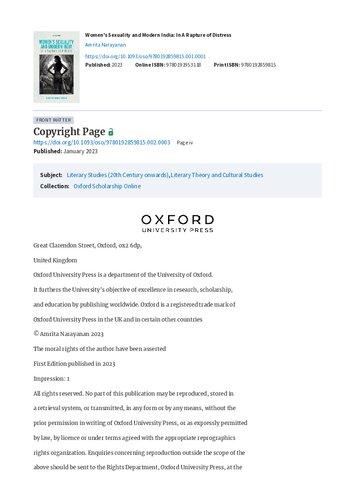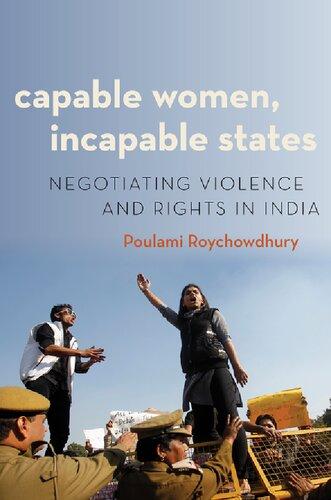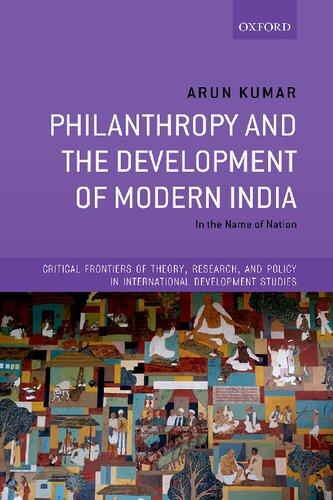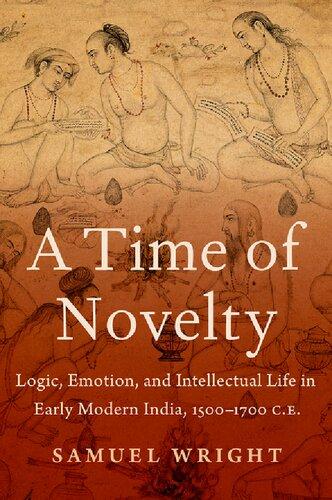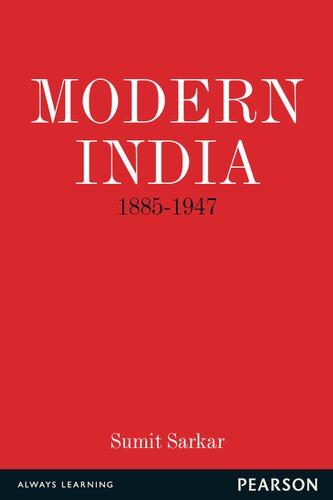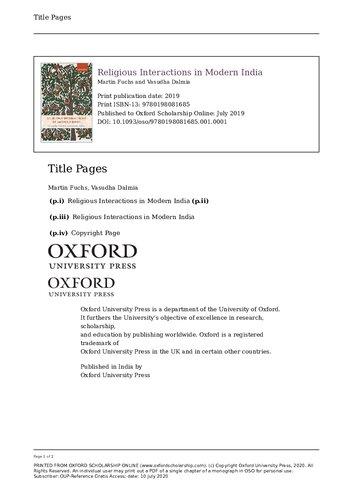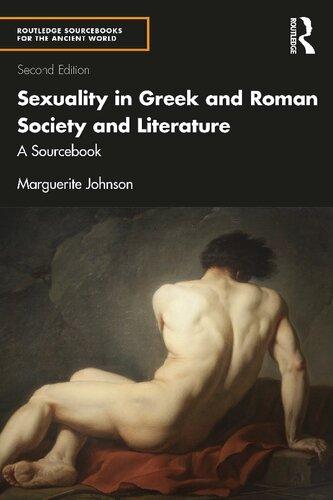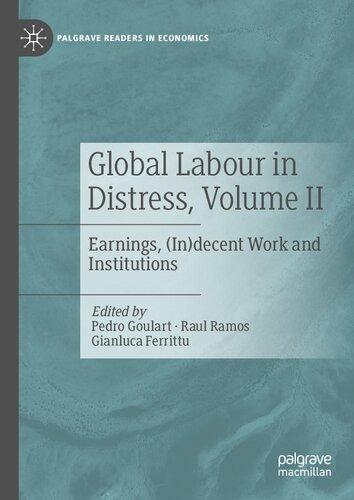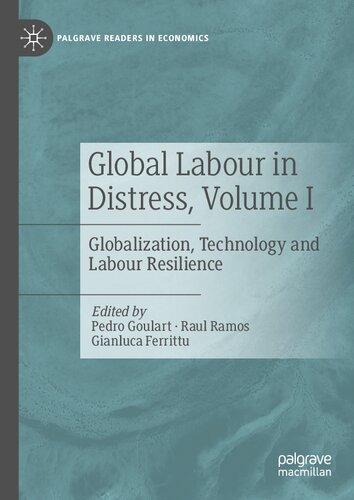Women's Sexuality and Modern India: In a Rapture
of Distress Amrita Narayanan
Visit to download the full and correct content document: https://ebookmass.com/product/womens-sexuality-and-modern-india-in-a-rapture-of-d istress-amrita-narayanan/
More products digital (pdf, epub, mobi) instant download maybe you interests ...
Capable Women, Incapable States: Negotiating Violence and Rights in India Poulami Roychowdhury
https://ebookmass.com/product/capable-women-incapable-statesnegotiating-violence-and-rights-in-india-poulami-roychowdhury/
Philanthropy and the Development of Modern India: In the Name of Nation Arun Kumar
https://ebookmass.com/product/philanthropy-and-the-developmentof-modern-india-in-the-name-of-nation-arun-kumar/
A Time of Novelty: Logic, Emotion, and Intellectual Life in Early Modern India, 1500–1700 C.E. Samuel Wright
https://ebookmass.com/product/a-time-of-novelty-logic-emotionand-intellectual-life-in-early-modern-india-1500-1700-c-e-samuelwright/
The Aeroplane and the Making of Modern India Aashique Ahmed Iqbal
https://ebookmass.com/product/the-aeroplane-and-the-making-ofmodern-india-aashique-ahmed-iqbal/
Modern India 1885-1947 Sumit Sarkar
https://ebookmass.com/product/modern-india-1885-1947-sumitsarkar/
Religious Interactions in Modern India 1st Edition
Martin Fuchs (Editor)
https://ebookmass.com/product/religious-interactions-in-modernindia-1st-edition-martin-fuchs-editor/
Sexuality in Greek and Roman Society and Literature: A Sourcebook 2nd Edition Marguerite Johnson
https://ebookmass.com/product/sexuality-in-greek-and-romansociety-and-literature-a-sourcebook-2nd-edition-margueritejohnson/
Global Labour in Distress, Volume II: Earnings, (In)decent Work and Institutions Pedro Goulart
https://ebookmass.com/product/global-labour-in-distress-volumeii-earnings-indecent-work-and-institutions-pedro-goulart/
Global Labour in Distress, Volume I: Globalization, Technology and Labour Resilience Pedro Goulart
https://ebookmass.com/product/global-labour-in-distress-volume-iglobalization-technology-and-labour-resilience-pedro-goulart/
FRONTMATTER
Women'sSexualityandModernIndia:InARaptureofDistress AmritaNarayanan
https://doiorg/101093/oso/97801928598150010001
Published:2023 OnlineISBN:9780191953118 PrintISBN:9780192859815
CopyrightPage
https://doiorg/101093/oso/97801928598150020003 Pageiv
Published:January2023
Subject: LiteraryStudies(20thCenturyonwards),LiteraryTheoryandCulturalStudies
Collection: OxfordScholarshipOnline
GreatClarendonStreet,Oxford,ox26dp, UnitedKingdom
OxfordUniversityPressisadepartmentoftheUniversityofOxford
ItfurtherstheUniversity’sobjectiveofexcellenceinresearch,scholarship, andeducationbypublishingworldwide Oxfordisaregisteredtrademarkof OxfordUniversityPressintheUKandincertainothercountries
©AmritaNarayanan2023
Themoralrightsoftheauthorhavebeenasserted
FirstEditionpublishedin2023
Impression:1
Allrightsreserved Nopartofthispublicationmaybereproduced,storedin aretrievalsystem,ortransmitted,inanyformorbyanymeans,withoutthe priorpermissioninwritingofOxfordUniversityPress,orasexpresslypermitted bylaw,bylicenceorundertermsagreedwiththeappropriatereprographics rightsorganization.Enquiriesconcerningreproductionoutsidethescopeofthe aboveshouldbesenttotheRightsDepartment,OxfordUniversityPress,atthe
addressabove
Youmustnotcirculatethisworkinanyotherform
andyoumustimposethissameconditiononanyacquirer
PublishedintheUnitedStatesofAmericabyOxfordUniversityPress 198MadisonAvenue,NewYork,NY10016,UnitedStatesofAmerica
BritishLibraryCataloguinginPublicationData
Dataavailable
LibraryofCongressControlNumber:2022949530
ISBN978–0–19–285981–5
DOI:10.1093/oso/9780192859815.001.0001
PrintedinIndiaby
RakmoPressPvt Ltd
LinkstothirdpartywebsitesareprovidedbyOxfordingoodfaithand forinformationonly Oxforddisclaimsanyresponsibilityforthematerials containedinanythirdpartywebsitereferencedinthiswork.
For my daughters
Men Thump their chests, Women beat their breasts. Rukmini Bhaya Nair1
With the farming of a verse Make a vineyard of the curse, Sing of human unsuccess In a rapture of distress
—W.H. Auden2
1
Sympathies and Oppressions
At a meeting that takes place on the pages of Manjula Padmanabhan’s dystopian novel, The Island of Lost Girls, women leaders come up with a solution for a post-patriarchal world: erase women’s memories. In Padmanabhan’s country, which is not-exactly-India but not unlike it, suffering at the hands of men is writ so large in women’s imaginations that they are habituated to using suffering as an anchor point for the self. Unless their memories were wiped, one leader, Vane, insists, women would continue to circulate stories of male aggression, using these stories as a currency of socializing, and keeping patriarchal history alive. If sharing these stories earned sympathy—as well they were entitled to— suffering would become competitive. In Vane’s words: ‘The most damaged girls would be disability queens. Misfortune would be their primary identity. They would become their injuries.’1
For women to recover from patriarchy, Padmanabhan’s fictional character seems to be saying, their memories of suffering have to become more distant. Paradoxically, in the psyche, memories demand to be given form and grieved before they can recede into the past. The narrative form that is this book is structured around a cohort of women’s memories of their everyday, not-explicitly-violent, sexuality under patriarchy between Indian Independence and before #MeToo.
In these kinds of sexual memories, suffering and pleasure can be hard to clearly separate. Memories of patriarchy simultaneously injure and animate women’s sexuality—their experience of pleasure-seeking fantasies, which push for enactment in diverse ways bodily and nonbodily.2 The memories are never alone: sponsoring fantasies—acts of the desiring imagination—get women into, out of, and around the injury of patriarchy.
I put out my first call for interviewees in 2011 at a mixed-age lecture series I gave in Ahmedabad. This hot, dry, riverside city has a tenuous, suspicious, relationship to psychological modernity—the capacity of an individual to think, imagine, and make individual meaning of her experience in the world. For the second series of interviews, in 2016, I chose the far more modernity-friendly cities of Mumbai and Bengaluru. There, I approached two women I knew whose demographics matched the Ahmedabad sample and they, in turn, referred others. Each interview, conducted over several months and in some cases upto a year, had only one question: that the woman, speak freely of her childhood and adult sexuality.
Twelve women narrated and remembered their sexual histories at length with me. All were economically privileged and self-identified as ‘middle-class’.3 The majority were upper caste and Hindus. Their birth years spanned a forty-year period: 1950–1990. They were located in Ahmedabad, Gujarat, Mumbai, Maharashtra, and Bengaluru, Karnataka.4 Aside from economic privilege they had in common luck: with the exception of one, none of them had been sexually abused. Aside from these twelve long-form interviewees, this work also includes brief quotations or anecdotes from a few participants who could only commit to a shortform interview, as well as quotes from a few psychotherapy patients who happened to speak to the subject of my study during the course of their therapy.
When I sat down with the completed interviews, I realized that it would not take me long to tell an oppression story: under equal conditions of economic privilege, sexual and ambitious desire experienced in a body that has been gendered5 as ‘woman’ lives a life unequal to sexual and ambitious desire experienced in a body that has been gendered as ‘man’. If I had approached my interview data in the way of mainstream psychology—which relies on externally observable and measurable data to speak about generalizable experiences—my book would have been a catalogue of oppression. My education had trained me to listen for pain, illness and oppression, overriding questions of difference. But along the way, I had become—dare I say it?—less interested in health and equality and more interested in difference. How did women find sexual agency—the experience of bodily desire accompanied by the power to realize that desire—under conditions of inequality? What are the diverse
inner processes by which different women constitute themselves as sexual subjects and agents? It is hard to arrive at these questions, because to write about the sexual agency of ‘unfree’ female bodies in the Indian geography, is to dialogue with the international imagination whose fantasies of ‘Woman’ and of ‘India’ tend to cast Indian women as stars of an oppression plot.
As an example, consider this personal memory from 2018. I am having breakfast with my two daughters at Corbett National Park, in Uttarakhand, North India. As we eat, and talk about our upcoming hike, I feel the eyes of a fellow tourist sizing me up. Then she leans over to me chattily. ‘I think it’s so wonderful how you are raising your daughters, bringing them to nature. It’s so important here, in India.’ The pointed indicator of geography makes the compliment dubious, of this I feel sure, so I smile and nod politely, the eggs on my fork slowing down only a little on their route to my mouth. She introduces herself, undeterred: she is Swedish, around my age—then early forties—travelling with her colleagues, two European men. I gather that all three of them work in strategy and planning for well-known international humanitarian organizations. They are intelligent, and funny, in their banter; the proxemics of the hotel breakfast table make me a captive audience. I join in, feeling the easy, not untrue, seduction of us cohering into a group that has in common the privileges of being educated and having travelled in each other’s continents. But a fantasy of shared geography underwrites this cohesion, and our interactions slowly give the lie to it. The woman points out the absence of a sign of marriage on my finger or neck. I confirm that I am indeed not married. Then she adds, still, warmly and kindly: ‘It must be so difficult for someone like you, living in India, raising daughters in a country where it is so oppressive for women.’
Such acts of imagined sympathy are difficult to refuse while still having good manners. By casting me as the Indian woman who struggled with oppression, the Swedish woman refused, indeed rid herself of, the possibility of her own oppression, simultaneously making equivalences between geography and liberation-oppression. While this claimed comparative advantage rankled, engaging in an argument to refuse the role in which I was being cast would have necessitated breaking up something to which I was also quite committed: the harmonious camaraderie of breakfast. After a moment’s hesitation, I convinced myself to save my feelings
for my ‘women notebook’, that was already by then several years into becoming the book you hold in your hands.
Sympathy—such as hers—denies the agency and the choices of its object. Such sympathy, if strong, unconsciously repeats the most familiar form of psychological misogyny: it refuses to recognize women’s sexual agency by casting women as suffering victims, and it offers women an emotional reward—in the form of attention—for participating in this casting. If women experience pity as a reward—a form of attention that feels pleasurable—they may unconsciously trade silence about their sexual pleasures and agency in exchange for pity, reinforcing the oppression plot.
Sexual pity, extended towards women in the plural, the denizens of a whole geography, is a form of liberal psychological colonization. Amidst alarm, and sympathy, a sotto voici narcissistic competition unfolds: the style of sexual liberation in the spectator’s geography is unconsciously asserted as aspirational.
Then, the pleasures of spectating upon or sharing suffering for spectatorship compete with and sometimes trump the pleasure of acquiring sexual agency.
Stories that articulate Indian women’s sexual desires and agency struggle for international media airtime. World media coverage has consistently signalled an association between women’s sexual oppression and India, an association that has strengthened since the internationally reported 2012 New Delhi rape case of Jyoti Singh Pande. While the global media reports Anglo-Saxon and European women’s sexual oppression alongside their agential projects of sex and love, stories of women’s sexual oppression from India are invariably exposés, reports from the front that unfold in isolation from stories of Indian women’s sexual agency. Thus, when it comes to sexuality, where curiosity should be, there is an outpouring of international sympathy for Indian womens’ fight against the oppressive men of their country. There has undeniably been a psychological impact to women in India from their participation in a social structure founded on the control of women’s sexuality. But the sympathetic label of ‘oppression’ functions as a further form of closure to their sexual agency. Once we call a group of women sexually oppressed, that title becomes another obstacle through which they have to work through to make their sexuality legible. Resisting a quick conclusion on oppression is critical to understanding the
particularities—including the discomforts—of women’s sexual agency in modern India.
Empirical research in psychology reinforces the popular idea that women who live in countries where individual rights and capitalism have authorized a sexual revolution—as with Europe and the United States in the 1960’s—have a comparative advantage in matters sexual. In 2002, the widely recognized empirical research of psychologists Roy Baumeister and Jean Twenge suggested that worldwide there is ‘a pattern of cultural influence by which girls and women are induced to avoid feeling sexual desire and to refrain from sexual behavior’.6 Women’s sexual suppression is universal, Baumeister and Twenge write effected via gossip, reputation and maternal socialization. Their meta-analysis of cross cultural studies overwhelmingly shows that if a country has had a sexual revolution then women feel free to acknowledge wanting more sex.7 Europe and North America, Baumeister and Twenge conclude, hyperbolically, have ‘defeated sexual suppression’.8
This kind of empirical research, like oppression plot media reporting, is oblivious to how its evangelical gaze affects its measurement instruments. What Baumeister and Twenge are referring to as the ‘defeat of sexual suppression’ is more accurately described as the presence of Highly Legible Sexuality. Measured by the verbal admission of interest in sexuality to an English-speaking researcher, Highly Legible Sexuality is not a culturally universal phenomenon, but Baumeister and Twenge seem to suggest we would all be better off if it was.
Thinking of sexual suppression and liberation in binaries asserts the dominance of a culturally monolithic model of women’s liberated sexual agency. When a culturally monolithic model is in the spotlight, forms of sexual agency and subjectivity that are less individualist and capitalist or that rely less on verbal expressions of desire become illegible. Psychoanalytic writer Jacqueline Rose, nails this monolith in her critique of the ‘Internet model of global feminism’ whose visual form is ‘a liberated Western woman in her pumps and smart skirt, toting a laptop en route to the airport’.9 Clearly recognizable as a sexual subject, the fact that this woman is alone, and dressed in Western clothes, signals via its optics, that aloneness and Western-ness—at least in dress—are as if essential for sexual agency. Together, the image of the woman dressed in Western clothes sitting at her laptop, and the empirical evidence that post-sexual revolution
countries consist of more sexually liberated women, form a screen that obfuscates the sexuality of women who wear different kinds of clothes, and who have not demanded a sexual revolution via a social movement. Binary and singular ideas on what sexual agency is—individual, capitalistic—and how it should be measured—external behaviours, verbal expressions, identity wars—foreclose what sexuality and sexual agency might look like in non-Western cultures.
For Indians, the solitary depiction of the Internet model of feminism runs counter to an empirical truth: India is a geography that values groups and inclusion; it celebrates superficial conformism. Empirical studies of decision-making styles amongst college students in India—like those in other Asian countries—show a marked preference for choices that favour real or imagined group harmony and inclusion, over individual desires.10 The tendency to function as a group is not a simplistic outward behaviour, but a way of experiencing the self: not as an atomized individual, but as part of a composite whole. Even as modernity’s loneliness is inexorable, so is the adhesive nature of the group in the inner world of Indians. Gender performances and project of sex and love are experienced not just as assertions of individual identity but also as contributions to the composite identity held by the group—the family, the community, or ‘Indians’ as a whole.
Unlike Rose’s image of a woman in a skirt at her laptop, a sari-clad woman making dinner is not a picture that the world immediately associates with sexual agency. But in truth neither sort of attire tells us anything for sure about sexual agency unless we know something of the woman’s inner experience, the identifications that are active at the time of the snapshot. Of course ‘woman’ itself is an interface between biological sex and a complex and contradictory set of identifications11 that affect projects of love and of ambition.12
Consider as a byline to the image of the woman making chappatis, these sentences from one of my respondents, Priyambata, a forty-sixyear-old, Tamil born, practising physician, who lives in the metropolis of Bengaluru: ‘I often make dinner, I don’t mind making dinner, but when my Mallu father-in-law visits us, and sits there in front of the TV, and I just know he is thinking sexist thoughts about me, I absolutely refuse to make dinner.’ The presence of her father-in-law as audience, for reasons
that we can’t know for sure but may have to do with his age, demeanour, and relatively rural background, re-signs Priyambata’s imagination (‘he is thinking sexist thoughts’), creating an unstated experience of oppression in a location and activity where previously there was none.
When I asked Priyambata to elaborate on those ‘sexist thoughts’ she giggled and said, ‘don’t spoil my mood’. Then she added darkly that her father-in-law felt that women owed him, and she thought that if he saw ‘a woman doing the cooking as usual’ it would make him even more entitled. Priyambata considered it part of her feminist praxis to give her father-in-law a political education by refusing him this comfort, even as she resented his presence, and the feminist labour she had to undertake when she would rather be going about her life as usual.
Not all women are equally affected by an oppressive Observer Effect in the presence of a male fantasy. The very demands Priyambata found humiliating, compromising and intrusive, another respondent, might have experienced as a sweet, childlike, and pleasurable to pander to. What predicts a woman’s response toward the effects of a male observer is not the nature of the sexism but the internalised meanings that its messages carry for the individual woman.
Backdrops, in the form of visible or invisible, internalized power and social contexts shape meaning, they define how experience is read and interpreted. The backdrop is not necessarily the external one: even if a woman is in a context that affirms the privileges that modernity has granted her, the appearance of an individual character—in Priyambata’s case her father-in-law—can replace the comfortable outside world by an invisible, internalized context that shapes how the individual woman reads and interprets her experience.
The experience of growing up in India and amongst Indians creates such an internalized backdrop. Micro-communications in the family and on the street deliver a common set of meanings to ‘woman’ and ‘woman’s sexuality’, which vary in their intensity by family and individual but have in common the memory of a collective history in which the control of female sexuality was used to provide psychological comfort and security for the social group as a whole. All my interviewees and patients had an embodied experience of growing up in India, undiluted with travel to the West prior to adulthood.
When traditional lives—organized around binary gender and the control of female sexuality—are lived alongside post-modern ones, the inner experiences of oppression, desire, and agency often collide. Is a slippery category-blurring account of women’s sexual agency particularly Indian? I suspect not. In Bad Feminist, 13 Roxane Gay eloquently reminds us that desire and agency defy external categorizations, and that it is possible to be a feminist while loving things that are at odds with feminist ideologies (think for instance of female-objectifying pop music).
‘Feminism’ and ‘feminist’ too are fantasy-packed notions, and not all of them based on women’s desires. As a classification, ‘feminist’ can have an invisibilizing effect on individual differences within a group of feminists. Card-carrying feminism, that demands a certain set of rules from women, can police women’s sexuality in a way that is both similar and different from patriarchy. For heterosexual women, feminist solidarity, to gain the psychological and economic advantages that are envied in men, can be at odds with heterosexual desire and competition for those men. Perhaps to offset this uncomfortable competition, the women I spoke to sometimes internalized feminism as an ego-ideal rather than a liberatory force, a subject I speak more of in the chapter Desire and Envy Amongst Unequals.
In their contemporary translation of the Kama Sutra in 2002, translator Wendy Doniger and psychoanalyst Sudhir Kakar describe that 4th- century text on Indian sexuality as part of a ‘war of psychological independence’ in which sexuality was separated from reproduction and women were located as free and willing subjects in sexuality. Where are women in India today in this war of psychological independence?
Consider that the first contemporary national-level public demand for women’s sexual subjectivity in India was in 2009: the Pink Chaddi campaign, during which women picketed the offices of a misogynistic political party with courier-deliveries of pink underwear. Driven by Facebook, the campaign was organized by ‘the consortium of loose, forward, and pubgoing women’, after some young male activists from a Hindu religious
group—Sri Ram Sena—attacked a group of young women for drinking at a pub in Mangalore. The Pink Chaddi campaign was far smaller and lesser known than the 2012 rape protests, and was India’s official entry into the third wave of global feminism, the feminism that in addition to political and economic equality asks for equal rights for women and men in the realm of the erotic.
Though it protested violence, the Pink Chaddi campaign was joyfully iconoclastic: pink was chosen because it was a frivolous colour; loose, forward, and pub-going contrasted with women as moral figures who wanted to be taken seriously. Like the Self-Respect movement in Tamil Nadu in the 1920s—the only other historic group movement in favour of women’s sexual rights in India—the Pink Chaddi campaign resisted the idea that women’s sexuality ought to be linked to respectability. They demanded that women publicly signing and signalling freedom and confidence be normalized.
While the Pink Chaddi campaign did not gain nearly the momentum of the anti-sexual violence movements of 2012, it was the first public expression of sisterhood that sympathized with women’s sexuality even as it demanded their safety. It clarified women’s rights to the expression of sexual vibrancy and freedom as an ongoing issue, alongside the fight against sexual harassment and rape whereas previous generations of feminists had viewed these as separate priorities.
Sexuality has been the factor upon which the feminist ethos of 1950s post-independence India breaks with the feminist ethos of post-liberalization and millennial India. Unlike the feminism of 1950s America, Indian feminism never gave way to the 1960s sexual revolution ethos. Instead, anxieties about national pride and concerns with bolstering India’s fragile post-colonial identity were such, that when the 1960s sexual revolution was unfolding in the West, psychoanalysts, novelists, translators, and cultural critics in India were delving into a conversation on Indianness and on Indian identity that had begun just prior to India’s Independence from England.
In the midst of this conversation on Indianness, diaspora novelist V.S. Naipaul,14 psychoanalyst Sudhir Kakar,15 and translator and cultural critic A.K. Ramanujan16 agreed, in their correspondence and crossreferencing of each other on certain characteristics of ‘Indianness’ that
seemed central to their cultural moment. Indianness, they wrote, was the tendency to function as if part of a group; the tendency to be swept away by archaic emotions that harken to a glorious past; and, the tendency to view the imagination (inner reality); and the real world (outer reality) as well as the body and the mind in a continuous rather than a discrete fashion. Though it would be monolithic and excessive to insist that all Indians embody these psychic tendencies, it is interesting that each of these characteristics resists the raw individualism of atomized modernity.
That self-defining as Indian became important in contemporary India at the precise time that self-defining individual sexuality had become very important in the west shaped how women in India have gone about the fight for sexual agency.
In 1928, at a lecture at the Women’s University of Calcutta, in the wake of Katherine Mayo’s exposé on the oppression of Indian women, Indian politician, poet, and feminist activist Sarojini Naidu insisted that Indian women address the concern of their gender oppression autonomously and independently. Addressing ‘The Women of India’ Naidu warned, famously, against: ‘all those who come in the guise of friendship to interpret India to their world and exploit their weaknesses and expose the secrets of home’.17 What these ‘secrets of home’ might have meant to Naidu— who helped garner the vote for Indian women in 1947—will remain a matter of speculation, but what seems clear is a conflict of loyalties between identifications as ‘Indian’ and as ‘Woman’.
For most of the 20th century, the excess of sympathy in the Western gaze towards Indian women has been the basis of a rift between Indian and International feminisms. Indian feminism has had a longstanding project of resisting the projections involved in the imagined monolithic Imperialist gaze as much as it has had a project of resisting the male gaze. Was one of the ‘secrets of home’ the complex and shifting set of signs and signals surrounding women’s agency both sexual and ambitious, in which women in India seemed to trade but never put language to? A screened and secretive agency, doubling as a feminine performance, secures India’s peculiar destiny in the international imagination. For, even as international and local projections assemble together to give imaginative power to the woman in Western clothes ‘winning’ the ‘battle’ for sexual agency, they accord a fascination and mystery to the sexuality
of women who wear colourful draped clothes instead of muted, monochrome, tailored ones.
Women’s sexuality in India has held both exotic and belittled places in the international imagination at different points in history. For my part, I first heard it publicly spoken that India had a reputation as a centre of medieval sexuality in 1992. I was seventeen years old, at a boarding school programme that gathered students from 100 countries. There, the first many months were spent exchanging real and imagined ideas about other cultures. Given our age, the sexual imagination of other cultures naturally formed a topic of fascination.
A fellow student, a young woman from Ireland, asked me, in an awed voice: ‘have you ever read the Kama Sutra?’
On a whim, taking advantage of the small audience of foreigners, I said, in a bold burst of adolescent bravado, that I had not only read the Kama Sutra, but that it formed a normal part of education in all Indian schools. ‘History, geography, Kama’, I explained proudly, producing a real transcript and telling my awed audience that Kama was indicated on my transcript by the acronym S.U.P.W. ‘SO lucky’, gasped the others, and I basked in the few moments of incredulous admiration before I too collapsed in giggles, and confessed my prank, perhaps a tad anxious about the audaciousness of my claim, or the perversion of S.U.P.W. that Gandhi-inspired acronym on my transcript that actually expanded to ‘Socially Useful Productive Work’.
One American student, of Iranian descent, was not amused. She wrote me a long private letter that I found later in my mailbox. I remember recoiling in shock and guilt at one of its sentences: ‘I think it’s sick how you have betrayed the conservative culture that you are from.’
Outside of India the world may have all but forgotten representations of India as erotic, but the question of the way India is imagined, whether as sex-positive or as sexually conservative, continue to be of concern to a large group of upper-middle-class Indians. In September 2019, I flew to Mumbai to record a podcast with an Ob-Gyn, who runs a series he advertised as: ‘She says she’s fine: a show about the rarely spoken concerns of Indian women’s bodies and sexuality.’
Amongst the questions I was asked on the show was the invariable one, versions of which I have been asked during interviews, and on literary festival panels over the last eight years: ‘What is responsible for the discrepancy between India’s history as the land of erotic literature and Indians’ shame about sex and the erotic?’ It’s a question that is rarely asked anymore outside of India, yet continues to preoccupy the imagination of a certain Indian demographic: English-speaking, though bilingual, professional, middle-class but with sufficient leisure to read and usually born before 1991, the year that India’s economic liberalization began. When it is asked, the question carries a tinge of regret, suffused with the liberal hope, of hearing that the accused will be a guilty party in the clear historical past, the British colonizers perhaps, maybe the Mughals before them, or earlier still, the puritans among the Hindu Brahmins.
My response is that the idea of ‘India’ in sexuality is not constituted by actual Indian history but by how Indianness is defined in the family. Between India’s past reputation as an erotic haven and its present reputation as a sexually oppressive place for women to live, are generations of family dynamics that shape the sexual imagination. It is family dynamics that mediate the possibilities of an imagined relationship to an erotic India, a conservative India, or a global future in which Indianness might not matter.
Consider the following moment, from the audience question hour at a 2018 literature festival held in the metropolis of Pune:
A woman in her mid-twenties has just raised her hand. Attractive by conventional standards, dressed in a pantsuit, speaking in articulate English, the latter two considered the outward signals of Indian modernity, she politely thanked us for our panel, on the erotically positive in medieval Indian literature and art. Then, shifting voice registers, she asked her question, with palpable annoyance, ‘So what’, she said, ‘so what if there is a “yes” for women’s sexuality in Indian medieval literature? Does it make any difference for me? Look at my conservative parents. Look at my commute to work!’ All day, she said, on the street on her way to work, and at work itself, she had to fend off male desire in the form of harassment: ‘I keep saying no, no, no, the whole day, I am so exhausted from saying no. Could any of you answer how I am going to get to a yes?’
That a discussion on sex and romance in medieval India could ignite an experience of disappointment, annoyance, and a re-experiencing of
harassment is a snapshot of a cultural moment in which the authorization to discuss harassment by men arrived so late and feels so invigorating it is difficult to talk about anything else. Before 2012, public sentiment in India discouraged public conversations both on sexuality and on harassment, after 2012, talking about harassment became almost compulsory.
Lalitha’s18 representation, of an Indian woman so harassed by men she cannot imagine pleasurable sex with them, corresponds closely to the imagined world of an Indian woman in the eyes of the Swedish woman with whom I began this chapter. Lalitha’s question was also a complaint about her own individual loss of Eros, the consequence of an excess of adaptation to a low grade but intrusive, sexually harassing, external environment. Lalitha’s experience, in which the harassment is ever-present, even when it is gone, is a clear example of trauma to erotic agency. In trauma something is remembered that would rather be forgotten. The remembered reality of the street situation and her family situation had inserted itself in to the comfortable, physically safe, air-conditioned ambience of a literary festival, adding the psychological mindset of these remembered audiences to the live audience: ‘Look at my conservative parents. Look at my commute to work!’ Given her audience, the reading of India that our panel had offered, an idea of a medieval India in which sexuality had been central, only seemed to point disappointingly to a world of possibilities that were closed to her.
Is it fair to call the deprivation of women’s sexual agency a trauma when far worse forms of trauma abound? While mainstream psychology has been attentive to material forms of damage done by patriarchy—such as female circumcision, sexual abuse, and rape—it has not sufficiently operationalized the damage done to women by subtle social constructions that deny them sexual agency and other correlate forms of power. On the other hand, the trauma of patriarchal restrictions upon women’s sexuality in India is clearly not comparable at all to once and for all large-scale sexual traumas—like the rape camps of the Bosnian war—nor to individual sexual traumas like sexual abuse.
Indian born British psychoanalyst Masud Khan gives us a term— cumulative trauma—to differentiate between large-scale traumas that have a definite end-point from traumas that derive from the stressors that a child experiences while dependent on its parents for its well-being— like growing up under patriarchy.
For Khan, cumulative trauma is what happens when, due to external events a parent is unable to play a psychologically protective role what Khan called an auxiliary ego function—towards his or her child. Protection and permission for sexual excitement and aggression are necessary for sexuality to be nurtured, and for Eros to remain available for the adult. At a time when the child’s capacity to manage excitement as well as to decide what excitements are permissible is immature and unstable, the parent needs to step in the role of an auxiliary. Except, until recently, in India, social factors made caregivers uncomfortable or unable to provide an auxiliary ego function for girls’ sexuality. My interviews suggest that for most parents, it was too difficult to provide a nourishing environment for girlish excitement—the psycho-sexual swaggering and showing off necessary in the developmental stage of childhood. Parents were diverted from their protective responsibilities as individuals, by an unconscious internalization of the group norms of the patriarchal community that for centuries has used the control of female sexuality as psychological scaffolding for the community psyche.
Lalitha’s complaint during the question hour captured the particularly Indian problem of auxiliary ego malfunction: there is an unbroken continuity between the street situation and the family situation when both demand a suppression of women’s sexual desire and agency (‘Look at my commute to work! Look at my Indian family’). What is equally remarkable was Lalitha’s rejection of atomized modernity: she pressed the panellists for a sexual agency ‘solution’ that would not ‘disturb’ her family. When I replied: ‘maybe you can do something your family is not ok with’, Lalitha appeared upset, even enraged, and several audience members clicked their tongues in annoyance and in disapproval of my comment.
Whither women’s sexual agency in the post-2012 public climate, where parades of women’s sexual freedom or complaints about its lack are still not well-received, but complaints about oppression experienced at the hands of men are? How can women authorize their sexual selves when the spectators to their lives welcome them narrating the oppression of their sexual selves? How do women sit with relationship networks that oppose their sexual agency but still represent love, respect, or pleasure? What happens when a woman experiences a painful delight in giving up sexual agency for someone she loves—in the family or in the world—who opposes it? How do we account for the women who desire aggressive
forms of agency in non-sexual realms, but lean towards classical gendered sexual aesthetics in sexuality? How does patriarchy define itself sexually and where does it locate women in those definitions?
These questions, to which I will keep returning, reflect the complexity of simultaneously fighting and mourning patriarchy. Mourning is a necessary step to recovering Eros. Grieving loss makes way for new possibilities: it has the possibility to release the past and create space for a reimagined future. Yet the benefits of mourning are made complex by its attractions.19 Patriarchy must be grieved in order to gain sexual agency where previously there wasn’t. But it is a complicated bereavement: patriarchy is not dead, and does not live only outside the self. Women do not have grieving rituals for patriarchy—though feminists protests might count—and too often women are more rewarded for grieving than for claiming sexual agency.
When my interviewees—women in India born between 1950 and 1990—spoke about their sexuality it seemed clear that to experience power, pleasure and agency in sexuality, they would need to eliminate some aspects of patriarchy while preserving others, and they often missed what they had confidently eliminated. Unsuccess and success in sexuality are not binaries here: the comfortably victorious antagonism connoted by ‘sexual revolution’ is an inadequate language for a battle in which there are injuries to the self. Under the historical condition of not-even-close-to-post-patriarchy in India, I argue for a definition of sexual agency that is not measured by outer behaviour or by objective definitions of ‘freedom’ but by an internal capacity and confidence to realize bodily arising desires, and to choose them—in reality if possible and in fantasy if not—over internalized idealizations from patriarchy or from feminism.
Such a self-authorizing sexual agency does not bring ease or absence of suffering: it only promises the capacity and drive to navigate sexual desires with the self. In Sanskrit, the sexual centre of the self is known as ‘Swa-dhistan’, which translates as ‘one’s own self’. To choose one’s own self over other versions of self (and of woman) requires being only minimally vulnerable to others’ imagined views of oneself and is both pleasurable and uncomfortable. Like modernity itself, sexual agency is about uncomfortable choice and self-authorization. As the British psychoanalyst D.W. Winnicott wrote about health: ‘The life of a healthy individual is characterized by fears, conflicting feelings, doubts, frustrations, as much as by
the positive features. The main thing is that the man or woman feels he or she is living his or her own life, taking responsibility for action or inaction, and able to take credit for success and blame for failure.20
So if a woman gains pleasure from patriarchal sexual dynamics, to have sexual agency means to feel empowered to pursue her pleasure of patriarchal sexual dynamics, without feeling disabled by internalized shame or persecution experienced from within the self or from others.
As I come to the close of this first chapter, I’d be remiss if I did not disclose my own sympathies towards psychoanalysis. I cross-trained in mainstream psychology—known for being an empirical science—and psychoanalysis—a literary and narrative way of thinking known for its coherent and intellectually satisfying conceptualizations. Given the vacuum of empirical data on the sexual lives of economically privileged women in India—this book draws from psychoanalysis to create an overall narrative that offers coherence and intellectual satisfaction— while keeping windows open for difference—until such time as empirical psychology can step in with more data.
Psychoanalysis is particularly appropriate to study sex between patriarchy and modernity in India, because the history of psychoanalysis is the history of people transitioning to modernity, by making sense of the pain produced by living between old and newer ways of experiencing. Freud for example, used his self-analysis along with his literary readings to make a transition between the life that he had as a son of an orthodox Jewish wool merchant and the life that he made for himself in modernity as a thinker.21
In his 1974 essay ‘The Becoming of a Psychoanalyst’, Masud Khan describes psychoanalysis as ‘occupying an ambiguous terrain between literary writing proper and scientific dissertations’.22 Psychoanalysis, Khan seems to say—a sentiment echoed by writers such as Adam Phillips and Christopher Bollas—concerns itself less with the relief of symptoms and more with a person’s capacity to experience a literary version of themselves. I read the sexuality of women I spoke to—less in the binary language of illness and health or oppression and freedom, and more as a
meaning-making tool with room for the desires and realities of modernity as well as the fantasies and inheritances of antiquity.
As a form of literature, psychoanalysis in a particular geography is dependent upon, indeed derived from, the petit and grand récits of the culture in which that analysis unfolds. The link between a psychoanalyst’s experience and the literature— particularly the classics— of the culture is brightly illustrated in an 1897 letter that Freud writes to his colleague Fliess. Here, Freud attributes a universal meaning to a finding of his self- analysis— the young child’s attraction to the mother, because he finds its reflection in the literary oeuvre of Oedipus Rex: ‘the Greek legend seizes upon a compulsion which everyone recognizes because he senses its existence within himself.’ 23
Echoing the idea of literary mirrors and reflections in psychoanalysis, Adam Phillips describes psychoanalysis as ‘conversations taking place between the analyst, the patient, and all the books and stories each has read’.24 Sudhir Kakar substitutes ‘communion’ for ‘conversation’ in essentially the same sentence.25 The idea that the Indian psyche is anchored upon conscious and unconscious literary identifications is echoed by colonial era Indian psychoanalysts Girindrasekar Bose and Dev Satya Nand, and the late contemporary translator A.K. Ramanujan.
During interviews with me, women often referenced literary works or characters they had heard about. I too, frequently found resonances with literary works that I had read when I listened to them speak; the use of literature alongside psychoanalysis became a part of my methodology of reading.
As a subjective account of subjective experiences, this book aspires neither to generalizability—impossible in a small sample—nor an exhaustive coverage of women’s sexual desires—impossible under any circumstances. In addition, I do not present any woman’s story in great length or detail. To do so would be to suggest that we could ‘read’ women’s sexual lives in the history of a culture, which would be an inherently unstable enterprise: individual sexual lives cannot be read; they are not like books; their complexities elude such a reading. My aim is not to describe women’s stories but to describe the psychological
tasks—often akin to gymnastics—that help them enact—or bear—the conflict of psychological modernity with patriarchy in their sexuality. Truthful descriptions about these conflicts—what I hope to offer over the next many chapters—are not empirical generalizations but mirrors of reality, similar to those uncovered in literature and arrived at in psychotherapy rooms.
If I Win, We Lose
Something about women’s displays of triumph sits uncomfortably in the cultural imagination. This is not a particularly Indian story. Martin Amis, a barely woke spectator in The Games Men Play (1995), an essay about tennis, in The New Yorker, tellingly describes mourning as a feminine performance and winning as a masculine one.1 Amis—who clearly contributes to the very phenomenon he complains about—writes:
The essential difference is the nature of the desire. Men want to win. Women want to have won, attractively. Look at Jana Novotna. During the quarters and semis, she became marvelously vivid, only to swoon away in the final. It wasn’t that Jana stopped hitting winners or hitting hard or hitting deep. She stopped hitting into the tennis court. Then her face stretched in desolation, she wept in the arms of the Duchess of Kent. Try to imagine Jim Courier having a refreshing weep in the arms of the Duke. Victory goes to the man who wants it more. Victory goes to the woman who fears it less.2
In his account of tennis, Amis genders desire. The desire to win, he seems to be saying, is essentially male in nature. Due to this ‘essential difference’ in the nature of desire, Amis suggests that when Jana Novtna started to lose, she felt anxious about her womanliness: to console herself she undertook the feminine performance of grieving. When Amis writes, ‘Women want to have won, attractively’ he betrays his own aesthetic proclivities, even as he simultaneously essentializes female desire. When he adds that he at least cannot imagine men uniting in loss he tells us more about the limitations of his imagination than he tells us about women winning. But what is most salient is that Amis notes tropes in gender performance—women’s relatedness in loss played by Jana Novotna and the Duchess and men’s relatedness in victory, played
Women’s Sexuality and Modern India. Amrita Narayanan, Oxford University Press. © Amrita Narayanan 2023. DOI: 10.1093/oso/9780192859815.003.0002
by Jim Courier and the Duke—but misses how the presence of spectators shapes these tropes.
Gender performances—like aggressive ‘masculinity’ and tender mournful ‘femininity’ are scripts writ in the cultural imagination that become hyper available at times of tension. Why can’t Amis—nor perhaps any of us—imagine Jim Courier and the Duke crying? Spectators to a conventional gender performance, experience feelings of familiarity and belonging; we feel something akin to a soothing dopamine response at a familiar spectacle of patriarchy that betrays our collective inheritance.
Unlike in countries that are famously W.E.I.R.D.—Western, Educated, Industrialized, Rich, and Democratic—in which everyone is, at least theoretically, an individual with their own mind—Indians, particularly, cleave to an individual identity that sits, matryoshka like, within a composite community identity. In 2001, Sinha and Sinha’s empirical study of decisionmaking styles amongst Indian college students, suggests an Indian preference for hosting group and individual identifications simultaneously. In the study, when ‘I’ conflicted with ‘We’, the students made those choices in favour of the ‘I’ that gave the appearance of benefiting the ‘We’.3
In her 2019 volume, Infinite Variety: A History of Desire in India, Madhavi Menon suggests that if there is an Indian style of desiring, it prioritizes having a variety of identifications over having a singular identity.4 From his New Delhi psychoanalytic clinic Kakar wrote, in 1996: ‘Individual and group self are birthed simultaneously for Indians, a “We are” simultaneous to an “I am” ’.5
The Indian identification with ‘We’ derives its power not from a moral congruence with community laws but from the sensual memory of what it feels like to belong. Community love is an erotic love, with a unifying, bodily—though not sexual—emotional life: it exercises a bodily emotional influence throughout the lifespan; a form of identification replete with both luminous and dark possibilities.6 Community love is engendered through actual embodied experiences in childhood—skin memories—that create an affinity for group values within an individual identity. Skin memories are the pulse of Indian childhood, and, simultaneously at the heart of how gender is constructed in India.
By community here I mean not purely the material fact of nationality, but a set of psychological characteristics produced by the physical experience of living a community life in India. Features of such a community life include intense physical contact in early life (think children being fed by hands instead of spoons, carried by mothers who wear saris as a result of which there is close skin contact maintained with the child); intergenerational contact from early life onwards (think families in which aunts, grandparents, and cousins are intimates); focus on comfortable dependence rather than independence (in contemporary nuclear families this could include hired nannies who live with the family, hand-feed the child and give them oil massages, an Indian ritual tradition). These lived phenomena amongst the middle and upper-middle class, contributed— until recently—to an extended childhood with only a slowly building pressure to grow up.
Cross-cultural empirical research on women’s sexual suppression implicates gossip, reputation, and maternal socialization as the three main sources of sexual suppression. All three of these suppressants operate via informal localized networks that exist in the real world, and are duplicated in the imagination. Aunts and uncles, parents, and neighbours operating in the imagination serve as relational memory networks that shape—though rarely dictate—desire amongst middleclass women.
Women’s awareness of and interest in the internalized spectators to their life varies by their mood, setting and the external spectators present. Not everyone is equally conflicted—or conflicted in the same way—between individual and community desire. Women vary quite a bit in the extent to which the dramatic effort of juggling individual sexual agency with the real or imagined needs of the community troubles them.
Since I returned to India to practice, I was struck by a particular kind of female patient, a woman in whom the community’s input on her desire, does not sit comfortably. In this clinical phenomenon, women full of sexual agency present themselves with ‘symptoms’: the distressing aftereffects of involuntary sexual self-policing.
Like most analysts, I think of these kinds of symptoms as a way of experiencing the narrative truth in situations where the factual structures of reality and the narrative versions of society or family are inadequate to experience. Listen to a description of community love and individual agency in conflict.
Twenty-six-year-old Shibani (b. 1992) is a professional architect who bubbles over with workplace competence and agency: ‘I just know that I’m the best of my kind.’ Lying on the couch, during our first meeting, Shibani said that she was very happy with how her life was going, but was concerned about her conservative Punjabi family from whom she was separated by hundreds of kilometres (a fact that seemed to cement their concerns rather than give her freedom). Over the weekend, she said, there had been a scene at the local bar during which her ex-boyfriend had broken a bottle of wine—his angry declaration of loss at their recent breakup. She told the story in vivid, colourful detail, taking evident relish not only in the man’s distress (which she read as a sign of her desirability) but also in the ‘army of men’ (his friends) who were ‘ready to protect me’ (another symbol of her desirability as well as of her relational power). Then, she huddled over with anxiety and tears, describing how terrible she had felt the next few days, unable to work and racked with shame and guilt. With fugitive fear she muttered: ‘I come from a traditional family, I don’t want them to get the wrong impression about my living away from them.’
As we spoke, I strained to understand what the trigger had been for the arrival of the internalized audience of the traditional Punjabi family that Shibani was from. Her actual family after all would have no way of receiving this news. As she recounted it, Shibani had thoroughly enjoyed the dramatic display of possessive love, complete with the jilted Devdas style lover, rendered powerless and unable to get over her; she had ‘felt like a queen’ at the protection by his friends. Her shame began when she recognized the presence of an older woman present at the bar— the set where this scene unfolded— who also worked with her at the architecture firm. This older woman became a fantasized locus of gossip: she would spread word about Shibani’s sexual exploits which would somehow find their way back to Shibani’s nuclear family. Shibani imagined a loss of affection from this woman who reminded her of the other women in her home community in
Haryana. At work she went out of her way to gain this woman’s approval, but she concluded despondently: ‘Amrita, for days she just wouldn’t look at me.’
It is easy to see here, Baumeister and Twenge’s theory of how sexual suppression is transmitted. What is invisible, but also true is the imagined disapproval from a perceived mother figure, Shibani’s investment in maintaining, via imagined gossip, her good reputation in the universe of antiquity. Her cleaving suddenly to archaic values seems directly related to an imagined—but viscerally experiences as ‘true’—fear of a loss of love from her family.
Shibani’s ‘symptoms’ are a vista into the conflict that arises when a much-wanted individual sexual liberation develops alongside generational and group identifications that idealize denied sexual agency for women. On another occasion, she told of a pleasurable experience of casual sex that she had initiated. Following this enjoyable sexual experience with a man, she found herself pursuing and making demands upon him to consider marrying her. Her demands performed an interest in him as a future partner that far outweighed her actual interest in him. Previously, on numerous occasions she had described him as boring, patriarchal, and without much to offer her except ‘stability and security that I don’t need because I have plenty of my own money’. Yet, she was full of outrage when he agreed with her. She wanted to have him back, she said, not because she missed him, but because his absence filled her with shame. Restless and sleepless, she repeated, over and over: ‘he can’t think that I’m that type of girl’. When I press her for what ‘type of girl’ she is referring to, she eventually says ‘the kind who would have a one-night stand’. Then she realizes the painful hilarity of this, and we share a moment of truthful uproarious laughter at the irony of her having to prove she was not the type of girl she clearly was.
Defences to the reputation sap energy and cause depression because they are an attack of the self on the self. One part of the self-engages in behaviour, the other rebukes her sexy double, exposing a conflict in the sexual values of the individual and the group. Anachronistic regressions to the sexual values of previous generation get experienced in the body as an urgent pressing need, much like a sexual one, sometimes coupled with the eroticized aggression that is the characteristic feature of misogyny. When Shibani spoke of her abandonment, shame, and guilt after casual
sex, I felt deeply moved for how helpless she seemed. Yet, when she spoke about how she stalked the man to demand that he introduce her to his family, I felt an odd admiration for the aggressive pleasure she was experiencing in her pursuit, then a tremulous anxiety about the intrusions she was making into the man’s life, and eventually a compassion for the man she was stalking. I was not, I felt, in the presence of the abandoned young woman who began the narrative, but her enraged father or brother who may have once enacted such a form of justice upon her would-be lover. What was especially notable was the vocal register in which she spoke, that carried no affection, heartbreak, or longing. It was a mixture of violent aggression (‘He better not treat me like this’) and practical rational agency (‘He’s got a family business, I think I would be fine with marrying him, I’d be well-taken care of, He’s spoken to his mum about me, I think I’ll call her’). The reality of Shibani’s own financially successful professional life disappeared into the backdrop as she undertook an arrangedmarriage style evaluation of her meat-market purchase to restitute the memory of community honour.
To understand Shibani’s vacillations between erotic pleasure and triumph and personal despair, I remembered Kakar’s notion of the dual naissance of the individual and community bodies. Each time she had sex with a man who was not her husband, I thought, she was identified with her individual body which enjoyed the experience; soon after, she would identify with her community body—which seemed much more affectively powerful—feel shame for what she had done, and set about restituting the shame which involved attempts to marry the man involved.
What made Shibani anxious and panicked after casual sex was not the absence of the sexual partner but her own imagined self-image within the internalized community of her sexually conservative extended family. While her individual body took great pleasure in her sexual experience, the cultural body dragged heavily, a psychological reaction to her exercise of sexual agency. What made her feel better was an enactment that mimicked the imagined cultural reaction of her tribe: pursuing the man to demand the restoration of her honour. When she could not engage in such a misogynistic mimicry Shibani would experience the misogyny internally, as debilitating symptoms of sleeplessness and depression, punition
for sexual agency. Where triumph should have been, there was a melancholic vocal register.
Self-policing remembers and repeats the construction of gender. It marks a lost object—the mother or another woman who will approve a girl’s sexuality—as much as it grieves a proctored and circumscribed girlhood sexuality and aggression. Self-censure and policing for her were a relic of the values of the previous generation and love for the affectionate ties of that generation. By the time she adapted to the experience of this conflict, Shibani and I were jokingly referring to her post-casual sex rage as ‘missing the parents’.
Agni, whom I met in 2013, was another such patient whose depression and anxiety were a product of being caught between the gender and sexual ethos of two generations. Agni entered therapy with a written diagnosis of ‘Hysteria’ assigned by her local (male) psychiatrist and a prescription for the anti-psychotic Haloperidol that was strong enough to put down a person double her size. Both the ‘diagnosis’ of ‘hysteria’, which she presented when she arrived, and the doctor’s recommendation for the routine use of the anti-psychotic Haloperidol were bizarre to my 21st-century ears.7 Using hysteria as a diagnostic category harkens back to Freud’s chronological time period; imagining that such bouts of ‘hysteria’ could be addressed by the routine use of an anti-psychotic medicine is equally anachronistic.
I was told that the anti-psychotic had been prescribed for periods in which Agni became extremely suspicious of her husband’s fidelity, because, as she became enraged with him, she had fits of hitting herself on the head in helpless rage.
In Grudge and the Hysteric (1975), Masud Khan wonders out loud why the hysteric has to be so florid in their behaviour. He writes: ‘they are people who have no confidence that they can find a place in other people’s minds.’8 The ‘hysteric’ comes across with behaviour exaggerated to the situation because of their extraordinary hopelessness about being heard. This dovetails well with Diane Hunter’s definition of hysteria, ‘feminism without the networks’9 a woman’s counter-cultural struggle for sexual recognition.
Agni was stuck between sticky identifications: the experience of being an individual was alluring but affectively empty and isolative; the experience of being part of the family group was oppressive. At thirty she had earned an MBA abroad which she longed to put into action. She felt held back from following her desires in work and in love by two women.
Agni constantly referenced her mother and her mother-in-law. Her mother’s model of escaping the hierarchical culture in her hometown had been to connect with other aspiring middle-class women in ‘kittyparties’ that signalled upwardly mobile consumer culture, a life that held no appeal for Agni. Her mother-in-law’s model of adaption in which she reigned as supreme kindly mother and queen of the kitchen—the trope of the happily sacrificing nurturer—was likewise dispiriting. Agni was derisive of women whose ambitions were realized by children’s accomplishments and household work, and longed to have a business of her own but felt she lacked the backbone for it. She found her husband equally divided: supportive, but very much in favour of pleasing his own mother, her mother-in-law.
In the familiar style of a middle-class home, the domestic rhythms and architecture where Agni lived with her in-laws were structured to keep the genders separate but equal with gendered domains of power, and generational hierarchies preserved. Sexual and other forms of agency were generationally locked: Agni felt that her mother-in-law would not like her to work outside the home, she also felt her husband deferred her youthful sexuality to the imagined sensitivity of his mother: ‘We are not allowed to shut our bedroom door until everyone in the family has gone to sleep,’ she explained, ‘My husband clearly says “mummy will feel bad”.’ And, on another occasion: ‘I feel bad about delaying the start of my business but I know my mother-in-law prefers me like this, at home, where I can give her help and company.’
Women who appear hypersensitive to restrictions upon their freedom may appear hysterical (as the psychiatrist initially diagnosed Agni) or mentally ill, however it is worth viewing their sensitivities in the wider context of family and culture.
In Kakar’s 1978 work Inner World, the first account of psychotherapy in modern India from the vantage point of a practitioner, he writes, ‘one would expect the preference for sons, the cultural devaluation of
